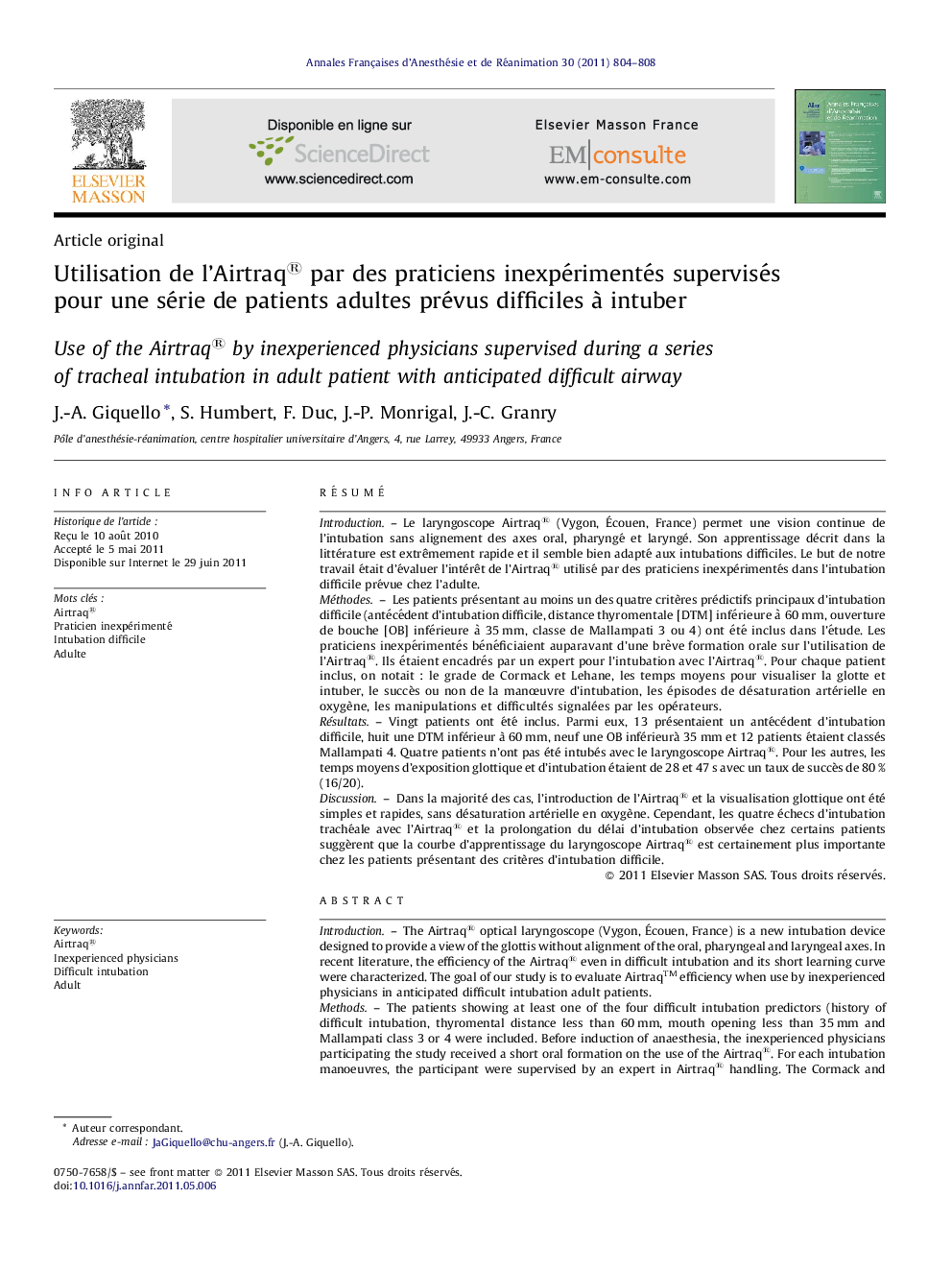| کد مقاله | کد نشریه | سال انتشار | مقاله انگلیسی | نسخه تمام متن |
|---|---|---|---|---|
| 2746177 | 1148864 | 2011 | 5 صفحه PDF | دانلود رایگان |

RésuméIntroductionLe laryngoscope Airtraq® (Vygon, Écouen, France) permet une vision continue de l’intubation sans alignement des axes oral, pharyngé et laryngé. Son apprentissage décrit dans la littérature est extrêmement rapide et il semble bien adapté aux intubations difficiles. Le but de notre travail était d’évaluer l’intérêt de l’Airtraq® utilisé par des praticiens inexpérimentés dans l’intubation difficile prévue chez l’adulte.MéthodesLes patients présentant au moins un des quatre critères prédictifs principaux d’intubation difficile (antécédent d’intubation difficile, distance thyromentale [DTM] inférieure à 60 mm, ouverture de bouche [OB] inférieure à 35 mm, classe de Mallampati 3 ou 4) ont été inclus dans l’étude. Les praticiens inexpérimentés bénéficiaient auparavant d’une brève formation orale sur l’utilisation de l’Airtraq®. Ils étaient encadrés par un expert pour l’intubation avec l’Airtraq®. Pour chaque patient inclus, on notait : le grade de Cormack et Lehane, les temps moyens pour visualiser la glotte et intuber, le succès ou non de la manœuvre d’intubation, les épisodes de désaturation artérielle en oxygène, les manipulations et difficultés signalées par les opérateurs.RésultatsVingt patients ont été inclus. Parmi eux, 13 présentaient un antécédent d’intubation difficile, huit une DTM inférieur à 60 mm, neuf une OB inférieurà 35 mm et 12 patients étaient classés Mallampati 4. Quatre patients n’ont pas été intubés avec le laryngoscope Airtraq®. Pour les autres, les temps moyens d’exposition glottique et d’intubation étaient de 28 et 47 s avec un taux de succès de 80 % (16/20).DiscussionDans la majorité des cas, l’introduction de l’Airtraq® et la visualisation glottique ont été simples et rapides, sans désaturation artérielle en oxygène. Cependant, les quatre échecs d’intubation trachéale avec l’Airtraq® et la prolongation du délai d’intubation observée chez certains patients suggèrent que la courbe d’apprentissage du laryngoscope Airtraq® est certainement plus importante chez les patients présentant des critères d’intubation difficile.
IntroductionThe Airtraq® optical laryngoscope (Vygon, Écouen, France) is a new intubation device designed to provide a view of the glottis without alignment of the oral, pharyngeal and laryngeal axes. In recent literature, the efficiency of the Airtraq® even in difficult intubation and its short learning curve were characterized. The goal of our study is to evaluate Airtraq™ efficiency when use by inexperienced physicians in anticipated difficult intubation adult patients.MethodsThe patients showing at least one of the four difficult intubation predictors (history of difficult intubation, thyromental distance less than 60 mm, mouth opening less than 35 mm and Mallampati class 3 or 4 were included. Before induction of anaesthesia, the inexperienced physicians participating the study received a short oral formation on the use of the Airtraq®. For each intubation manoeuvres, the participant were supervised by an expert in Airtraq® handling. The Cormack and Lehane grade of direct laryngoscopy view, the duration times to best glottis view and to intubate the trachea, the success or failure of tracheal intubation, the drop in arterial oxygen saturation of below 95%, the need for external manipulation, and the difficulties met by the operators were noted.ResultsTwenty patients were included over a month period. Thirteen had a history of difficult intubation, eight a thyromental distance less than 60 mm, nine a mouth opening less than 35 mm and 12 patients were classified as Mallampati IV. The success rate of tracheal intubation with the Airtraq® laryngoscope was 80%. Times to best glottis view and to complete tracheal intubation were 28 and 47 s, respectively. Four tracheal intubation failures were encountered. The LMA Fastrach® and the flexible fiberoscope were used respectively in one and three patients.DiscussionIn the majority of the cases, the insertion of the Airtraq®, the visualization of the glottis and the subsequent intubation were easy and rapid, without arterial oxygen desaturation. However, the four tracheal intubation failures associated with prolonged tracheal intubation times in some patients highlight the fact that the Airtraq® laryngoscope requires a clinical training process particularly in case of anticipated difficult airway management situations.
Journal: Annales Françaises d'Anesthésie et de Réanimation - Volume 30, Issue 11, November 2011, Pages 804–808